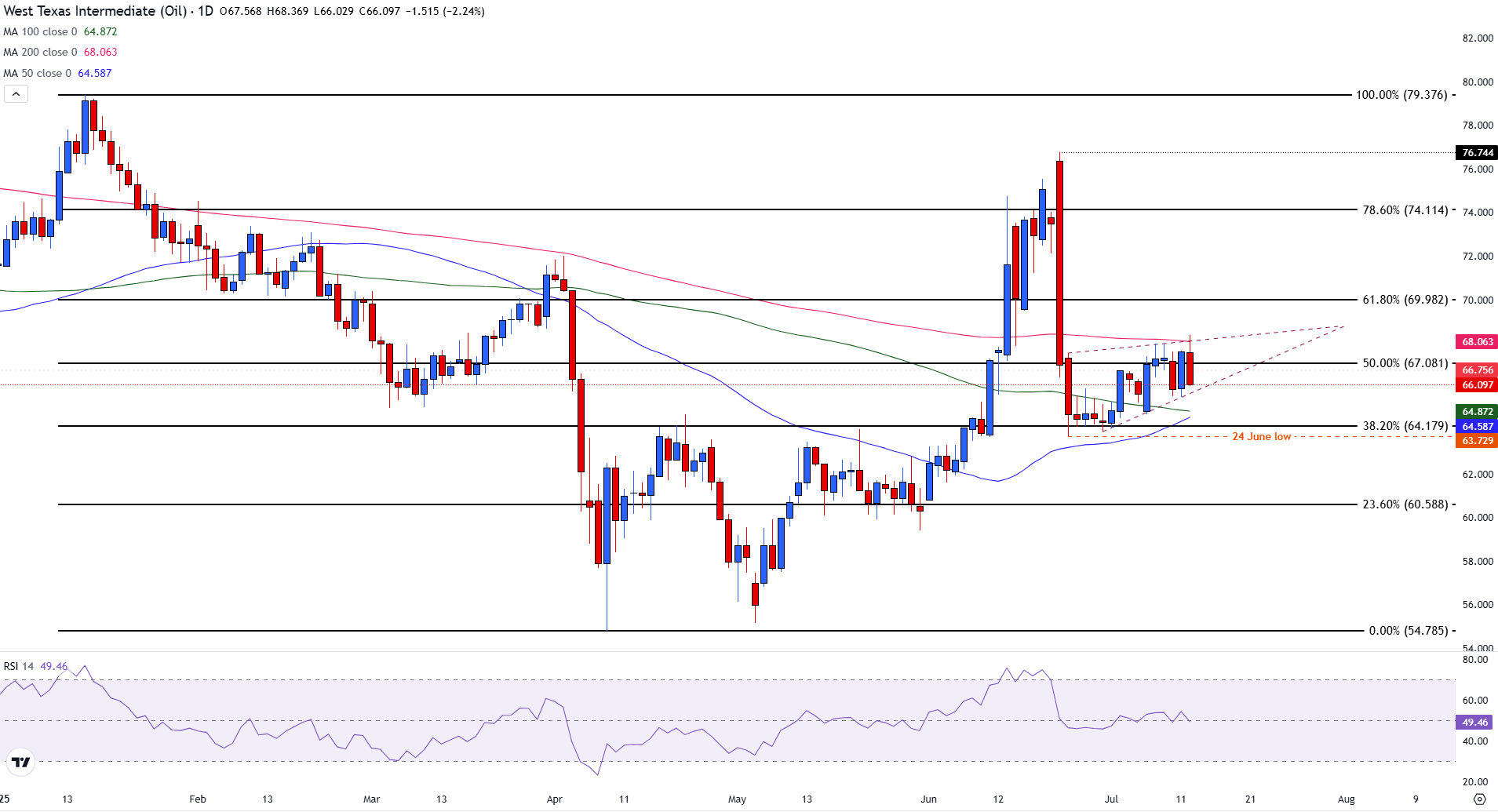- WTI crude oil falls more than 2% amid tariff threats and growing commercial tensions.
- President Trump threatens additional sanctions against Russia, with a period of 50 days for peace conversations with Ukraine.
- The WTI approaches psychological support at $ 66.00, with firm triangular resistance at $ 68.00.
WTI crude oil is falling abruptly on Monday, since commercial disputes on climbing and warnings against Russia weigh on feeling.
At the time of writing, the West Texas Intermediate (WTI) has lost more than 2% of its recent profits, with the price approaching 66.00 $.
During the weekend, US President Donald Trump threatened a 30% general tariff on imports from the European Union and Mexico, scheduled to enter into force on August 1.
These measures have revived concerns about the deceleration of global trade and energy demand.
In a separate development, President Trump delivered a warning to Russia during a joint press conference with NATO general, Mark Rutte, at the Oval office on Monday.
Trump announced a 50 -day period for Russia to reach a high fire agreement with Ukraine. If Moscow does not comply, he promised that the United States would impose “very severe secondary tariffs”, including a 100% tax on Russian goods.
“We are going to impose very severe tariffs if we do not have an agreement in 50 days – tariffs of about 100 percent, the secondary calls,” Trump said. “It’s great to solve wars.”
These comments, covered by Bloomberg, add up to the complex geopolitical panorama that already influences oil markets.
The daily oil chart WTI shows that prices have recently been removed after failing to stay above the resistance of the simple mobile average (SMA) of 200 days of 68.00 $.
The price action is currently quoting above the level of psychological support of $ 66.14, with the Fibonacci setback level of 50% of the fall from January to April providing resistance at $ 67.08.
The 50 -day and 100 days SMAs are providing additional support at $ 64.59 and $ 64,87, respectively. The price action is rolling inside a symmetrical triangle, indicating an accumulation for a possible break.
WTI crude oil daily graphics

However, the relative force index (RSI) is neutral about 50, showing a lack of impulse in any direction.
A decisive movement below the triangle could expose the minimum of June 24 at 63.73.
On the other hand, a break would be necessary above $ 67.08 and the 200 -day SMA at $ 68.06 to change the bias to Alcista. For now, the configuration is inclined to neutral with a slight bearish bias after the recent rejection.
WTI oil – frequent questions
WTI oil is a type of crude oil that is sold in international markets. WTI are the acronym of West Texas Intermediate, one of the three main types that include the Brent and Dubai’s crude. The WTI is also known as “light” and “sweet” by its relatively low gravity and sulfur content, respectively. It is considered high quality oil that is easily refined. It is obtained in the United States and is distributed through the Cushing Center, considered “the crossing of the world.” It is a reference for the oil market and the price of WTI is frequently traded in the media.
Like all assets, supply and demand are the main factors that determine the price of WTI oil. As such, global growth can be a driver of the increase in demand and vice versa in the case of weak global growth. Political instability, wars and sanctions can alter the offer and have an impact on prices. OPEC decisions, a group of large oil -producing countries, is another key price factor. The value of the US dollar influences the price of WTI crude oil, since oil is mainly traded in US dollars, so a weaker dollar can make oil more affordable and vice versa.
Weekly reports on oil inventories published by the American Petroleum Institute (API) and the Energy Information Agency (EIA) influence the price of WTI oil. Changes in inventories reflect the fluctuation of supply and demand. If the data show a decrease in inventories, it can indicate an increase in demand, which would raise the price of oil. An increase in inventories may reflect an increase in supply, which makes prices lower. The API report is published every Tuesday and that of the EIA the next day. Their results are usually similar, with a 1% difference between them 75% of the time. EIA data is considered more reliable, since it is a government agency.
The OPEC (Organization of Petroleum Exporting Countries) is a group of 13 nations oil producing that collectively decide the production quotas of member countries in biannual meetings. Their decisions usually influence WTI oil prices. When OPEC decides to reduce fees, it can restrict the supply and raise oil prices. When OPEC increases production, the opposite effect occurs. The OPEC+ is an expanded group that includes another ten non -members of the OPEC, among which Russia stands out.
Source: Fx Street
I am Joshua Winder, a senior-level journalist and editor at World Stock Market. I specialize in covering news related to the stock market and economic trends. With more than 8 years of experience in this field, I have become an expert in financial reporting.







